
|
|
|
|
 |
|
Home Site Search Contact Us Subscribe
|
|
|
|
Hillside Haven: Lexton/MacCarthy Residence by Lorcan O'Herlihy Architects
Silver Lake, California: Grounded in the tradition of mid-20th Century modernism (and grounded by stringent building codes) a new house seems to "float" effortlessly above the canyons of Los Angeles. by Kristen Richards May 2, 2002 Classic
stucco-and-red-tile Spanish-Mediterranean estates for movie stars and studio
moguls started dotting the hills around Los Angeles from the very beginning of
the Hollywood film industry. The Silver Lake area was particularly favored
because it was so close to the Hollywood studios. Beginning in the 1930’s
through the 1960’s, the sloping sites offered California modernists like
Wright, Schindler, Neutra, Lautner, and others, the opportunity to invent new
forms, transforming the hillside house into a contemporary building type.
(Local realtors point out that there are more architecturally significant homes
per square mile – both traditional and contemporary – in Silver Lake than in
other area of Los Angeles.) Continuing in the
contemporary tradition, a steeply sloping lot for the Lexton/MacCarthy
residence in Silver Lake presented Lorcan O’Herlihy Architects the same timeless challenges and no easy solutions.
In addition to the geographical conditions, the 1994 Northridge earthquake put
rather severe building codes into play. In an interview with the New York Times
earlier this year, Lorcan O’Herlihy said: "There's
no greater challenge than a hillside. It's a dangerous place to build." The program
called for a 2,000-square-foot house with a carport; the site’s sharp hillside
presented wonderful west facing views of Los Angeles. To O’Herlihy, everything
suggested “a formal strategy of abstract geometrical forms conceived as a play
of positive and negative volumes – straight dislocation.” He proposed creating
a new vocabulary for wood structures that would meet strict building codes and
still maintain the striking “lightness” of earlier modernist houses. Retaining walls, excavation, and site grading are typically
a major portion of the construction cost for hillside houses. The building pad
elevation and siting were considered to minimize the heights of retaining walls
and amount of grading. O’Herlihy made the code-required foundations and
supporting trusses part of the architecture rather than elements to be buried
and/or hidden. The house is wrapped horizontally in 1-by-6-inch pine siding
that “floats" away from the structure on 2-by-2-inch vertical spacers; the
second floor siding is stained blue. This visually establishes a horizontal
layer on the primary floor and vertical volume on the second floor. “The formal
simplicity allows for a greater focus on materials, proportions, and details,”
says O’Herlihy. “The abstract geometric forms stripped of superfluous detailing
reinforces the modernist reticence, but is mediated through the use of wood
surfaces that ‘play’ with the California light.” Given the limited square footage, the primary floor is primarily
a flexible open plan that includes living and dining
room areas, a kitchen, guest bedroom, and bathroom (and separate studios for
the professional couple). The living room fenestration on the west wall
is recessed, and dining
area windows are framed with glu-laminated beams; both treatments reinforce the
vertical lines of the house. The second floor, dedicated to the master bedroom
suite, seems to “float” above one section of the first floor. The carport
“breaks away” from the house with its path traced by a connecting stairway. A research component of the project identified Frank Lloyd
Wright’s Usonian houses as a point of departure. In this case, O’Herlihy’s
solution blurs the criteria that a building should reveal its construction at
first glance, and instead allows the skin to wrap the structure with glass,
concrete, and wood. Lorcan O’Herlihy’s explorations in residential design were
recently featured in “The
New American House 3,” and “Lorcan
O’Herlihy” (Contemporary World Architects series). Client: Kevin MacCarthy,
Lauren Lexton Architect: Lorcan O'Herlihy
Architects Design Team: Lorcan O'Herlihy (Principal in Charge), Michael Poirier (Project Manager), Danika Baldwin, Ricardo Diaz (Project Team) Structural Engineer: Paul Franceschi General Contractor: Ben Harrison, Adam Savage Photography: Douglas Hill Lorcan O’Herlihy Architects was founded
in 1989. O’Herlihy has taught extensively over the last decade including the
Architectural Association, where he was Unit Master and the Southern California
Institute of Architecture (SCI-Arc), where he was a graduate studio instructor. Previously,
O’Herlihy worked at I.M.Pei and Partners on the Louvre Museum in Paris and as
an associate at Steven Holl Architects, where he was responsible for several
projects including the award winning Hybrid building in Seaside, Florida, which
received a National Honor Award from the American Institute of Architects. Currently on the boards are a number of
commercial and residential projects in the U.S. and Europe. The firms’ work has
been recognized internationally with a number of awards, exhibitions, and
publications, and has appeared in Progressive Architecture, Architectural
Record, Abitare, Architectural Review, The New York Times, and the Los Angeles
Times. Also featured on
ANN: Habitat 825 by Lorcan
O'Herlihy Architects |
(click on pictures to enlarge) 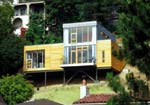 (Douglas Hill) The west elevation of the Lexton/MacCarthy Residence in Silver Lake.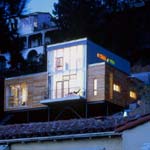 (Douglas Hill) The house in the dusk.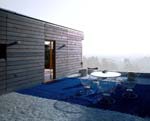 (Douglas Hill) View from the roof terrace (Douglas Hill) The door leading to an outdoor garden.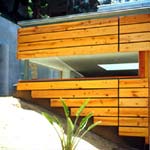 (Douglas Hill) Exterior pine siding "floats" away from the structure on 2-by-2-inch spacers.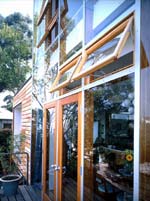 (Douglas Hill) Detail of the corner windows.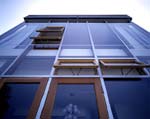 (Douglas Hill) Detail of the windows.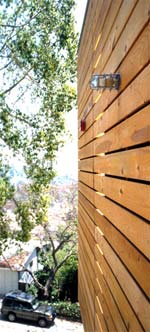 (Douglas Hill) Detail of pine siding.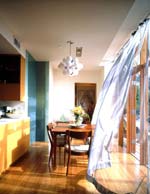 (Douglas Hill) The dining room.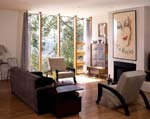 (Douglas Hill) The living room.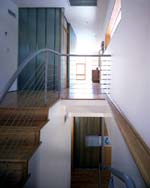 (Douglas Hill) View of the stairway.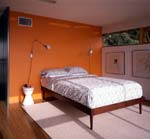 (Douglas Hill) The master bedroom.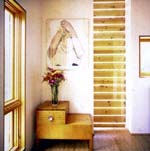 (Douglas Hill) One of two home-office studios.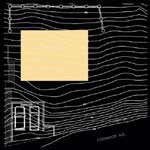 Site plan Site plan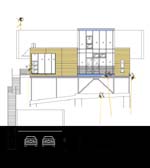 West elevation West elevation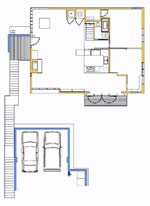 First floor plan First floor plan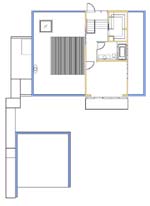 Second floor plan Second floor plan |
© 2004 ArchNewsNow.com